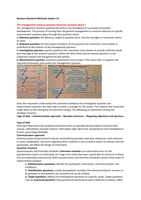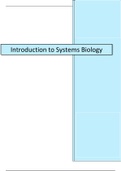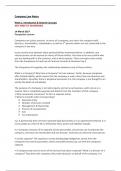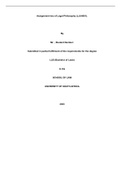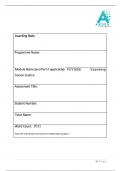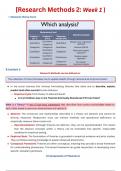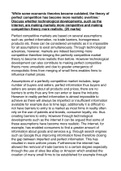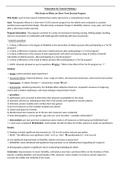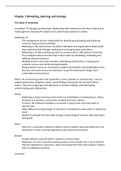Business Research Methods chapter 14
The management research question hierarchy revisited: phase 1
The management research question hierarchy is the foundation of successful instrument
development. The process of moving from the general management or research dilemma to specific
measurement questions goes through four question levels:
1. Dilemma question; the dilemma, stated in question form, that the manager or researcher wants
to solve;
2. Research question; the fact-based translation of the question the researcher must answer to
contribute to the solution of the management question;
3. Investigative question; specific questions the researcher must answer to provide sufficient detail
and coverage of the research question; within this level there may be several questions as the
researcher moves from the general to the specific;
4. Measurement question; questions participants must answer if the researcher is to gather the
required information and resolve the management question.
Once the researcher understands the connection between the investigative question and
measurement question, the next step is to plan a strategy for the survey. This requires the researcher
to get down to the nitty-gritty of instrument design. The following are prominent among the
strategic concerns:
Type of data – Communication approach – Question structure – Disguising objectives and sponsors.
Type of data
Data type determines the analytical procedures that are possible during analysis (nominal (man-
vrouw), ordinal(eens-neutraal-oneens), interval(kan lager dan 0 zijn, temperatuur) and ratio(absoluut
0-punt, percentages/leeftijd))
Communication approach
Communication-based research may be conducted by personal interview, telephone, mail computer
or some combination. Decisions regarding which method to use, as well as where to interact with the
participant, will affect the design of instrument.
Question structure
Questionnaires and interview schedules (interview schedule is an alternative term for the
questionnaire used in an interview) can range from those that have a great deal of structure to those
that are essentially unstructured. Both questionnaires and interview schedules contain three types of
measurement question:
1. Administrative questions; identify the participant, interviewer, interview location and
conditions;
2. Classification questions; usually demographic variables that allow participants’ answers to
be grouped so that patterns are revealed and can be studied;
3. Target questions; address the investigative questions of a specific study. Target questions
may be structured questions (they present the participants with a fixed set of choices, often
The management research question hierarchy revisited: phase 1
The management research question hierarchy is the foundation of successful instrument
development. The process of moving from the general management or research dilemma to specific
measurement questions goes through four question levels:
1. Dilemma question; the dilemma, stated in question form, that the manager or researcher wants
to solve;
2. Research question; the fact-based translation of the question the researcher must answer to
contribute to the solution of the management question;
3. Investigative question; specific questions the researcher must answer to provide sufficient detail
and coverage of the research question; within this level there may be several questions as the
researcher moves from the general to the specific;
4. Measurement question; questions participants must answer if the researcher is to gather the
required information and resolve the management question.
Once the researcher understands the connection between the investigative question and
measurement question, the next step is to plan a strategy for the survey. This requires the researcher
to get down to the nitty-gritty of instrument design. The following are prominent among the
strategic concerns:
Type of data – Communication approach – Question structure – Disguising objectives and sponsors.
Type of data
Data type determines the analytical procedures that are possible during analysis (nominal (man-
vrouw), ordinal(eens-neutraal-oneens), interval(kan lager dan 0 zijn, temperatuur) and ratio(absoluut
0-punt, percentages/leeftijd))
Communication approach
Communication-based research may be conducted by personal interview, telephone, mail computer
or some combination. Decisions regarding which method to use, as well as where to interact with the
participant, will affect the design of instrument.
Question structure
Questionnaires and interview schedules (interview schedule is an alternative term for the
questionnaire used in an interview) can range from those that have a great deal of structure to those
that are essentially unstructured. Both questionnaires and interview schedules contain three types of
measurement question:
1. Administrative questions; identify the participant, interviewer, interview location and
conditions;
2. Classification questions; usually demographic variables that allow participants’ answers to
be grouped so that patterns are revealed and can be studied;
3. Target questions; address the investigative questions of a specific study. Target questions
may be structured questions (they present the participants with a fixed set of choices, often


